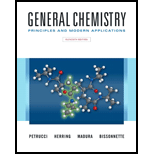
Concept explainers
(a)
Interpretation:
The nucleophile, electrophile and the leaving group in the following substitution reaction should be determined.
Concept introduction:
Substitution reactions are the
Nucleophiles are the electron-rich species that donate an electron pair in the reaction and electrophiles are the electron-deficient and accept an electron pair in the reaction. The leaving group is a part of the molecule that departs or leaves with a pair of electrons in the heterolytic cleavage.
A substitution reaction favors product formation if a weaker base is formed relative to the nucleophile and vice-versa.
(b)
Interpretation:
The nucleophile, electrophile and the leaving group in the following substitution reaction should be determined.
Concept introduction:
Substitution reactions are the chemical reactions in which an atom, ion or group in one molecule is replaced by the other. These are also known as the single displacement or single substitution reactions.
Nucleophiles are the electron-rich species that donate an electron pair in the reaction and electrophiles are the electron-deficient and accept an electron pair in the reaction. The leaving group is a part of the molecule that departs or leaves with a pair of electrons in the heterolytic cleavage.
A substitution reaction favors product formation if a weaker base is formed relative to the nucleophile and vice-versa.
Want to see the full answer?
Check out a sample textbook solution
Chapter 27 Solutions
GENERAL CHEMISTRY-MOD.MASTERINGCHEM.
- Identify the reagents needed to come up with the given compounds. Pls Separate the reagents with a comma and a space. (ex. HNO3, H2SO4). For a multi-step reaction, separate the reagents with a semi-colon. (ex. HNO3, H2SO4; CH3Cl, AlCl3) There should be 9 reagentsarrow_forwardWhat is the rate law implied by the mechanism given below? CH3COCH3(aq) + H+(aq) ←→ CH3C(OH)CH3+(aq) (fast, reversible) CH3C(OH)CH3+(aq) → CH3C(OH)=CH2(aq) + H+(aq) (slow) CH3C(OH)=CH2(aq) + Br2(aq) → CH3C(OH)CH2Br+(aq) + Br-(aq) (fast) CH3C(OH)CH2Br+(aq) → CH3COCH2Br(aq) + H+(aq) (fast) A. Rate = k[CH3COCH3][H+] B. Rate = k[CH3COCH3] C. Rate = k[CH3COCH3][Br2] D. Rate = k[CH3COCH3]2 E. Rate = k[CH3COCH3][Br2]/[H+] (Answer is A, looking for explanation why!).arrow_forwardWhat is the major product of the reaction of 2-methyl-2-butene with each of the following reagents? a. HBr b. HI c. Cl2/CH2Cl2 d. O3, −78 °C, followed by (CH3)2S e. H2/Pd f. MCPBA (a peroxyacid) g. H2O + H2SO4 h. Br2/CH2Cl2i. Br2/H2O j. Br2/CH3OH k. BH3 /THF, followed by H2O2, HO-, H2Oarrow_forward
- organic chemistry 7) What is the final product expected from the following reaction?arrow_forwardConsider the reaction of (R)-2-chloro-3-methylbutane with sodium iodide to form aproduct.1(a) Draw the reaction scheme with the correct stereochemistry (reactant + NaI → product+ NaCl). Circle the nucleophile and draw a rectangle around the electrophile. 1(b) What is the symbol used for mechanism shown in 1(a)?1(c) If the sodium iodide was replaced with sodium hydroxide, the product is anALKENE. Draw a reaction MECHANISM to show how this happens.1(d) Draw the reaction energy diagram for the reaction in 1(c) and label the activationenergy.1(e) Using any alcohol with five carbons, and any carboxylic acid with six carbons, draw areaction to show how we would make an ester. 1(f) Describe the practical on esters.arrow_forward. Given the reaction below: N2(g) + 3H2(g) -----> 2NH3(g) deltaH = -92.6 KJWhat is the value of deltaH for the following reaction? 2NH3(g) -----> N2(g) + 3H2(g)arrow_forward
- Tunicates are marine animals that are called "sea squirts" because when they are taken out of water, they tend to contract and expel seawater. Lepadiformine is a cytotoxic agent (toxic to cells) isolated from a marine tunicate. During a recent synthesis of lepadiformine, the investigators observed the formation of an interesting by-product (3) while treating diol 1 with a reagent similar in function to PBr3 (J. Org. Chem. 2012, 77, 3390–3400):arrow_forward5) Ethyne (CH≡CH) has a pKa of 25 and water has pKa of 15.7 and ammonia (NH3) has a pKa of 36. Write equilibrium reactions showing arrows that indicate whether the reactants or products are the favored for reaction of Ethyne with a. HO- , and b. with NH2 - and indicate which one is better for removing proton from Ethyne. Then calculate the equilibrium constants, Ke, for each equilibrium reaction. Are calculated Ke values match the expected results from prediction you made .arrow_forwardIn hydrobromination of 3-hexene, which of the following pairs of species act as nucleophiles? 3-hexene, Br– 3-hexene, HBr HBr, Br– HBr, Br2arrow_forward
- Can you match best nucleophile / conditions from the list that will give a successful hydrolysis reaction for each electrophile? (there's one best nucleophile / conditions for each electrophile) <List for Nucleophile / condition> a. LiAlH4; hydronium work-up b. PCC c. NaH d. CrO3 e. HOEt f. H3O+ or OH- g. H2O h. NaBH4;hydronium work-up Electrophile 1. Acid chloride 2. Acetic anhydride 3. Ester 4. Amide I'm asking again on bartleby because pther tutor gave me the right answer because I think I didn't make my question clear enough.arrow_forward6. Identify the best reagent(s) for this reaction. (see attached screenshot). a. H2SO4, HgSO4, H2O b. 1. Disiamylborane, 2. HO–, H2O2 c. K2Cr2O7, H+ d. NaOCl e. H2, Pdarrow_forwardChoose the best reagents from the list provided below for carrying out the following conversion. Match the reagent with the step number. HCl (aq), Zn(Hg) Br2, FeBr3 Na/NH3, -33 degrees C NBS, light KMnO4, H3O+ Mg metal, ether KOH, EtOH, heatarrow_forward
